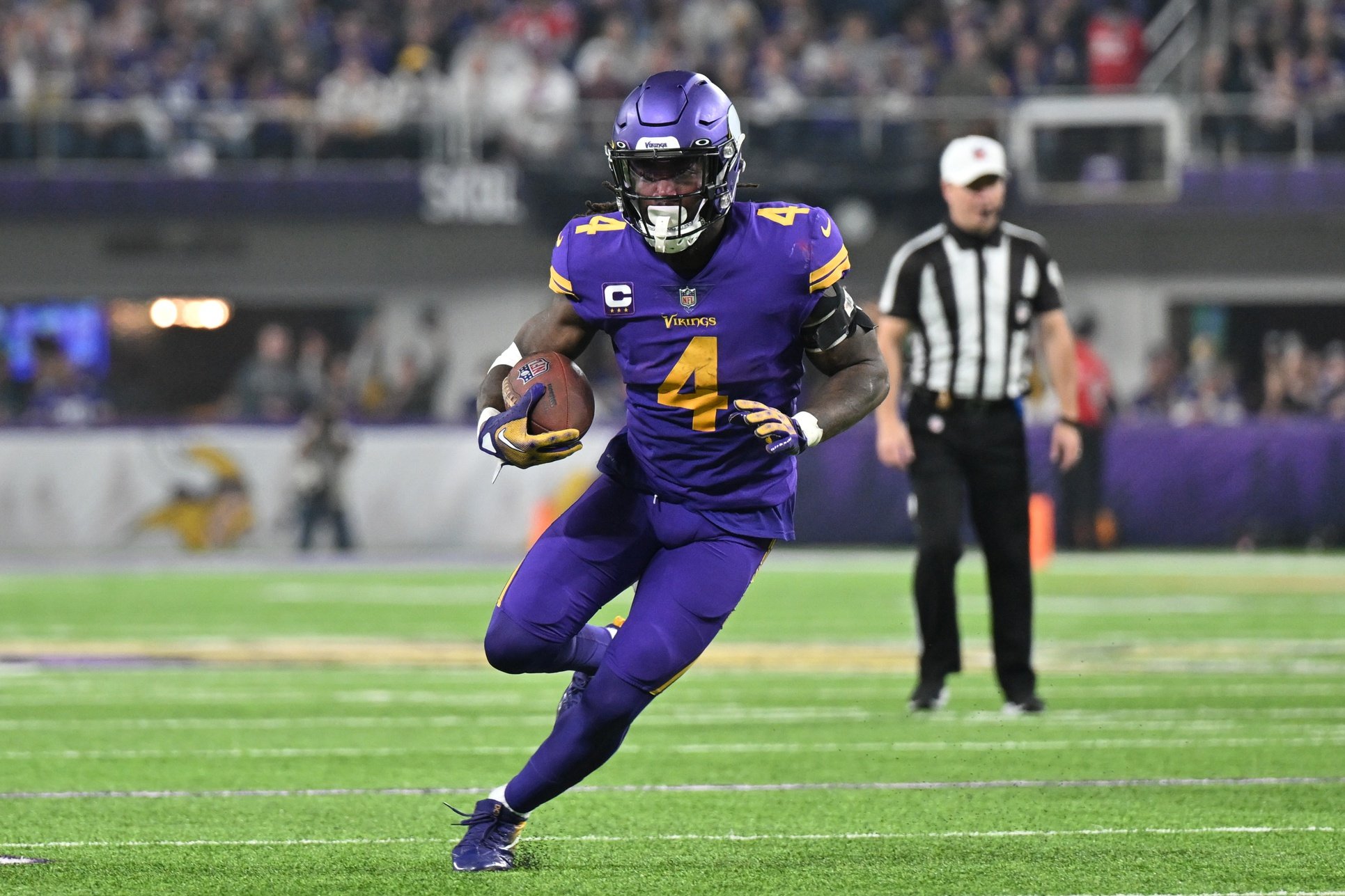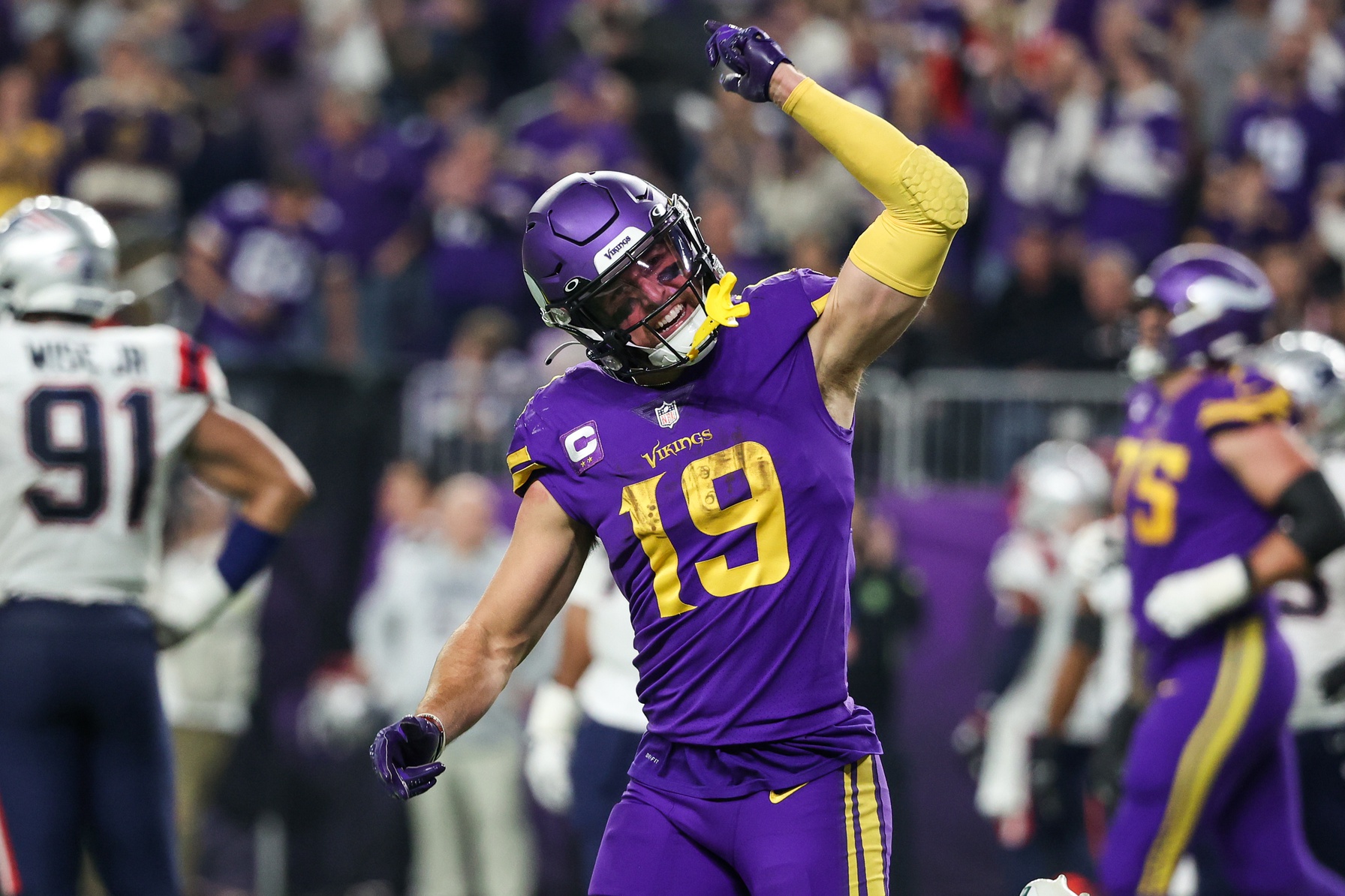The Minnesota Vikings were a surprisingly successful squad in 2022 despite turnover at head coach and in the front office. The biggest contributor to their 13-4 performance and divisional win might have been their offense; their special teams unit struggled all year, and the defense was among the league’s worst. With that in mind, it seems odd that they would move on from two high-profile names on the offense: running back Dalvin Cook and receiver Adam Thielen.
It’s not clear if the Vikings can live up to their offensive expectations, but without their marquee players, it may seem like those possibilities are even further away than when they started the offseason. Though neither Cook nor Thielen was likely to live up to their contract values with Minnesota, the question is whether or not their offense became net worse this offseason.
Jordan Addison Could Be an Upgrade Over Adam Thielen
The writing was on the wall for Thielen, whose cap hit was unwieldy given his production and age. The Vikings were likely already on the way to considering his replacement last year if the draft had fallen their way but instead invested in a first-round pick this year, selecting Jordan Addison from USC.
Thielen was not a particularly efficient receiver last year, generating 1.08 receiving yards per pass route run — 83rd of 102 qualifying receivers. By contrast, Justin Jefferson ranked second in the NFL with 2.55 yards per route run.
But Thielen didn’t have much difficulty getting open when he was on the field. The Vikings simply prioritized Jefferson, who was often the first read and often quite open.
The data available to us doesn’t tell us that Thielen was consistently a threat — he ranked 63rd in FiveThirtyEight’s wide receiver “open” score, which tracks targeted and untargeted pass routes using the chip data inside the player’s pads — but he did find himself available for plays late in the progression fairly frequently.
On the other hand, it wasn’t as if the Vikings forced Cousins to only track Jefferson on passing plays. Not only has Cousins had great chemistry with Thielen over the years, but he was more than happy to use T.J. Hockenson after the Vikings traded for him partway through the season.
In fact, Jefferson’s average depth of target increased after the Hockenson trade by a substantial margin, from 8.9 yards downfield to 11.7 yards. This suggests that the Vikings were more comfortable sending Jefferson on deeper routes once Hockenson was involved in the offense, perhaps because they needed to pay more attention to Hockenson.
This isn’t definitive — they may have realized screens were a poor strategy early in the year or might have needed both Hockenson and Thielen on the field at the same time for the full effect, but it is something worth chewing on.
The average first-round receiver since 2010 generated 1.72 yards per route run. In the last five years, when receiver classes have been seemingly chock full of talent, that average is 1.83. Last year, those averages would have ranked 37th and 29th among NFL receivers.
In total NFL yards, the average active first-round rookie receiver generated 803.9 receiving yards in their first season over the past five years and 750.3 since 2010. That would have ranked 34th and 40th among receivers in the NFL in 2022.
All of that is to say that the addition of Addison is likely to help more than losing Thielen will hurt the offense, at a lower cost. Averages can only get us so far, however — Jefferson, after all, wildly exceeded expectations in his rookie year. Still, two-thirds of rookie first-round receivers over the past five years beat Thielen’s yardage total, and virtually all of them beat his yards per route run.
The Vikings Probably Will Get Worse Running the Ball, and That’s OK

As for the running game, we’re left with a bit of a quandary. The only addition to the roster to cover for the loss of Dalvin Cook is seventh-round rookie DeWayne McBride, who can hardly be expected to fully replace what Cook brought to the table.
That said, what we know of running back production tells us that Cook didn’t bring as much as he typically does.
He ranked very low in rush yards over expectation, which purports to isolate running back performance by looking at the expected yards a typical running back can get given the scheme and blocking.
Cook also led the league in rushes for zero or negative yards and typically hurt the team more than he helped — despite the fact that teams would empty the box in order to better deal with the Vikings’ three-receiver formations and the dominance that someone like Jefferson provides through the air.
it was time for the vikings to move on from dalvin cook, especially given his 2023 cap hit
most GM's probably would have made this move but would definitely expect it from kwesi adofo-mensah given he's most likely looking at the same metrics we do pic.twitter.com/oqkLbknHFS
— Tej Seth (@tejfbanalytics) June 8, 2023
Cook’s poor production by RYOE comes from two different sources — NFL chip data, which suggested that Cook left 0.16 yards per carry on the field compared to a typical running back, ranked him 41st of 48 runners. PFF’s data, which uses player grades as its proxy rather than the tracking chips, ranked Cook 46th of 48 and suggested he left 0.75 yards per carry behind the average running back.
The data for running backs is still remarkably indeterminate, however, and Cook has demonstrated extraordinary skill in the past. He also still generated more than respectable yards after contact, which would imply that he invited contact earlier into plays even after accounting for blocking effectiveness. The Vikings were about an average run-blocking team, according to ESPN’s run-block win rate data, and Cook was producing mediocre numbers.
It’s unlikely that Alexander Mattison can fully replace his production — he often fares worse in the same metrics than Cook does, and his 2022 followed the same pattern. He ranked lower in yards after contact, yards over expectation, EPA per run, and yards per carry.
Mattison’s role would likely be different this year, so it’s difficult to compare what he’s done to what he’s expected to do, but it nevertheless gives us reason to wonder if the Vikings can find a way to upgrade in the run game.
They might see a boost if their investment in Ty Chandler last year pays off. Chandler primarily profiles as a receiving back, but if he can play a big role in the offense in either that capacity or in a more well-rounded role, he could provide a boost to the running game without costing too much. It’s also possible that McBride, whose college numbers are outstanding, or Kene Nwangwu — the likely fastest player on the roster — could provide a boost to the offense.
Minnesota’s response has been to invest more heavily into blocking — they signed Josh Oliver, a blocking tight end, from the Baltimore Ravens and intend to run heavier formations, with fewer three-receiver sets and more players in the box.
That may make up the difference, but the Vikings are likely banking on the idea that their play-action attack will be more successful — it’s not that they want their running to be more efficient than it was last year, but rather they want the threat of the run to be more impactful.
In that sense, it doesn’t matter as much that they don’t have Cook on the roster. Signing Oliver may have a bigger impact on the passing game despite the fact that neither the blocking tight end nor the running back directly impact receiving all that much.
In the spirit of that mindset, the Vikings might be in a place where they end up with a more efficient overall offense despite likely downgrading their running game.

